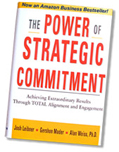
Conventional wisdom says that total alignment and commitment is an unrealistic expectation. Everyone knows compliance is as good as it gets. People know what they’re supposed to do. They’re compensated to do it. As long as they don’t screw up or stray too far from what’s expected then everything should be fine.
Accepting that as the best your organization can do results in an environment of compliance at best and cynicism, resignation, and apathy at worst. An employee at a large company I’m working with said to me the other day: today was a really good day; nobody asked me to do anything. Someone else said by way of introduction at a team meeting: I can’t remember how long I’ve been here but I have 54 months to go.
That simply isn’t a sufficient level of commitment to compete these days since there are people all over the world who can do just about anything you can do faster, cheaper and often better, so commitment has got to be robust in order to keep, much less grow, your place at the table.
When it comes to alignment I’ll often hear people say things like: Well, we can agree to disagree. …or, let’s find middle ground we can both agree to.
When that happens, you don’t get alignment, you get consensus, which is watered-down compromise no one has any strong feelings against. As soon as initiatives start to go off track or change, people will opt out. And things will change, because the world is moving so fast, as soon as a plan is written, there has already been a shift.
People will say: I told you so…or you should’ve asked me….or see?
So, yes, it’s common to hear and see that compliance is a good as it gets.
I’d like to offer an alternative way to think about whether or not you want to accept that for your organization.
The norm on participation rate on employee service is 30%. That’s 30% participation, not 30% satisfaction. A leader will say: let’s get it to 50% and people will bring forward all kinds of statistics about how that’s impossible. So, the energy goes towards justifying the statistic argument rather than everyone pulling together to make the higher performance goal into reality.
Imagine if someone said to you they could promise that roughly 15% of their customers would be satisfied with the products they offer. No one would buy from that vendor.
Yet, that’s the level of engagement, participation and alignment leaders are settling for within their own organization. That’s just way too low when you can invest an incremental increase in time for the phenomenal payoff of true alignment and real commitment. That’s the prize – that’s what’s transformative.
What challenges have you encountered in getting your people committed and engaged? Have you identified ways to impact this in your organization? Please share with us – we would love to hear from you.


It depends on the corporate culture, some are more successful at building the participatory environment. Usually it requires perks.
People need to feel their futures, fortunes, worth and happiness are wrapped up in these things. So the company has to foster that kind of environment, their has to be a big carrot (stick and carrot)
Honestly, I wish it were different, but I’m happy with compliance these days.
No idea, but if anyone has any ideas, feel free to share.
The problem is, it’s work for 99% of people, not something they are passionate about, just a way to pay the bills.
So, how exactly do you suggest going about achieving this?
Nothing wrong with a little compromise now and then.
Pretty sure compliance is the best you can get.